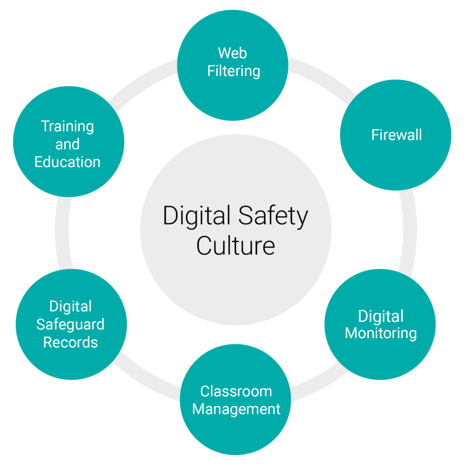
Digital safety involves the whole school community: pupils-parents-teachers-leadership-governors-IT staff-finance.
By involving all stakeholders in creating a digital safety culture, not only will the school community be better protected, but pupils will gain better outcomes.
How a strong digital safety culture in schools will include the whole school community:
Parents: Need to be aware. Schools with a strong digital safety culture will include parents in their education programme of online safety. Parents need to be aware of the safety systems schools have in place and the risks students face. Best practice schools will share an acceptable use policy (AUP) so that parents are aware of expectations and the consequences of miss-use. They also will want to see evidence if their child has slipped up so that they can better understand the problem.
Students: Need to stay safe. Strong digital safety culture in schools will allow pupils to work in an exciting digital environment. Pupils should be able to access modern resources without exposure to risk. They need to be able to grow in resilience in the online environment and understand how their digital actions may have consequences. Best practice will ask students to sign an AUP.
IT Staff: Are needed to manage the school safety systems. A strong school digital safety culture will not waste IT staff time. Intuitive technology will create a robust culture that can easily provide a granular approach.
Teachers: Need to be backed-up with safety systems. A strong digital safety culture in schools will enable teachers to identify problems without holding up lesson times and learning. It will support teachers in delivering high quality lessons with good access to resources and classroom management technology to check all students remain on task.
Leadership: Need to be sure their pupils are fully protected without having a negative impact of the school IT systems. They need to ensure that pupils at risk are successfully identified by proactive monitoring systems and that safeguarding records are easily managed for efficient follow-up.
Governors: Need to be sure that their school digital safety culture is meeting digital safety compliance. They need to see that staff are trained in online safety and that pupils are being protected from harm.
Finance: Want to check that a strong digital safety culture in schools is built at a quality-value level. Finance will want to ensure that components do not become costly through confliction between different safety elements.
How to create a strong digital safety culture in schools
There are six strands to a strong digital safety culture and each are important for optimising digital safety in your school.

The components of a strong digital safety culture in schools:
- Filter: A good content filter will enable dynamic access to a wide range of resources while making sure the community is protected from harmful content and contact.
- Firewall: A firewall is needed so that if any school community member that accesses the school network will be protected from cyber-attacks that could jeopardise school data.
- Proactive monitoring: Digital monitoring works actively on a school network to check for any signs of a pupil at risk. If a concerning chat or internet search takes place, a good system will raise an alert to notify a school DSL in real-time.
- Classroom management: Crucial for optimum pupil engagement, a good classroom management option will help students stay on task and make digital lesson delivery simple and easy.
- Digital safeguard records: A good solution will optimise safeguarding within your school. It will enable secure, instant access for the appropriate connected staff and will be able to remind staff to check follow-up.
- Education: All stakeholders should be regularly updated on the changes in digital safety. Training and resources should be provided at every level of the community. Smoothwall has a partnership with National Online Safety who offer workshops and handouts for the latest safety information.
Want to learn more?
If you have any questions about any aspect of online safety in your school, get in touch with the Smoothwall team today. We’d be delighted to help.
Contact usFurther reading
You may also be interested in other articles from our ‘Digital Safety Culture’ series:
-
How you can create a digital safety culture for your whole school community
- How to improve digital safety across your school, college or multi-academy trust
- Improving teaching and learning by creating a strong digital safety culture in your school
- Lesson wreckers! Is your school, college or MAT’s digital safety culture up to the job?
- How can a strong digital safety culture in your school, college or MAT help to reduce staff workload?
- How a strong digital safety culture help tackle cyberbullying in your school, college or MAT
- Planning a digital safety culture in schools: how to ensure your safety solutions work together
- How to use a combined solution to create a strong digital safety culture in your school, college or MAT
- How to build pupil resilience by creating a strong digital safety culture in your school, college or MAT
- Weak vs Strong Digital Safety Culture: A day in the life of two schools
- The unique digital safety challenges Independent Schools face and how to address them
- Why is it important for Independent Schools to build a strong digital safety culture?